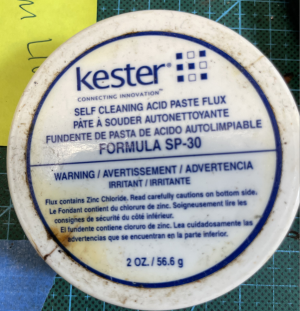After using (and loving) my Bottlehead Crack for a year with HD 650s, I decided on the Speedball upgrade.
The stock Crack would occasionally begin making “dying squirrel†noises which could easily be remedied by quickly turning it off and on again. I’ve always assumed this is just a tube irregularity but thought I’d mention it here in case it serves as a clue.
Anyhow, here’s the actual subject of this post:
After a successful “small circuit board†voltage check, I assembled and installed the “large circuit board†so as to complete the Speedball upgrade for my Bottlehead Crack. It passed both resistance checks, and then came time for voltage tests. In total I applied power to the amplifier three times in an attempt to conduct the voltage tests, and each time an alarming issue would arise. Provided below is a timeline of said issues:
1st time power applied (not caught on video):
Sparks and smoking between the “base†and “emitter†legs of the TIP-50 transistor in the Q2A socket after ~30 seconds. Assuming this was due to flux arcing from improper cleaning between the transistor legs, I wiped the area thoroughly with rubbing alcohol and decided to retry the test.
2nd time power applied (not caught on video):
Sparks and smoking between two of the legs (not sure which) of the TIP-50 transistor in the Q2B socket (NOT the Q2A socket) after ~4 minutes. Assuming this was also due to flux arcing from improper cleaning between the transistor legs, I wiped the area thoroughly with rubbing alcohol and decided to retry the test.
3rd time power applied (caught on video):
Smoke from an unknown location (appeared to be under the large circuit board) after ~15 seconds. Please take a moment to observe this on video: youtube.com/shorts/bDFA4OeiegE?feature=share
YouTube has decided to convert the video I posted into a “YouTube shortâ€, which disallows slow-mo playback. This happens automatically to every video under 60 seconds posted in vertical video format, which I find very frustrating.
If you’d like to watch the video in slow motion, please just download it so you can scrub through it slowly with your computer’s built-in playback software.
If anybody needs photos, please don't hesitate to let me know.
If you’ve read this post up until now, I commend you. What an incredible community this is!
Thank you all so so much.
Jordan B.
Amateur Audiophile
The stock Crack would occasionally begin making “dying squirrel†noises which could easily be remedied by quickly turning it off and on again. I’ve always assumed this is just a tube irregularity but thought I’d mention it here in case it serves as a clue.
Anyhow, here’s the actual subject of this post:
After a successful “small circuit board†voltage check, I assembled and installed the “large circuit board†so as to complete the Speedball upgrade for my Bottlehead Crack. It passed both resistance checks, and then came time for voltage tests. In total I applied power to the amplifier three times in an attempt to conduct the voltage tests, and each time an alarming issue would arise. Provided below is a timeline of said issues:
1st time power applied (not caught on video):
Sparks and smoking between the “base†and “emitter†legs of the TIP-50 transistor in the Q2A socket after ~30 seconds. Assuming this was due to flux arcing from improper cleaning between the transistor legs, I wiped the area thoroughly with rubbing alcohol and decided to retry the test.
2nd time power applied (not caught on video):
Sparks and smoking between two of the legs (not sure which) of the TIP-50 transistor in the Q2B socket (NOT the Q2A socket) after ~4 minutes. Assuming this was also due to flux arcing from improper cleaning between the transistor legs, I wiped the area thoroughly with rubbing alcohol and decided to retry the test.
3rd time power applied (caught on video):
Smoke from an unknown location (appeared to be under the large circuit board) after ~15 seconds. Please take a moment to observe this on video: youtube.com/shorts/bDFA4OeiegE?feature=share
YouTube has decided to convert the video I posted into a “YouTube shortâ€, which disallows slow-mo playback. This happens automatically to every video under 60 seconds posted in vertical video format, which I find very frustrating.
If you’d like to watch the video in slow motion, please just download it so you can scrub through it slowly with your computer’s built-in playback software.
If anybody needs photos, please don't hesitate to let me know.
If you’ve read this post up until now, I commend you. What an incredible community this is!
Thank you all so so much.
Jordan B.
Amateur Audiophile

